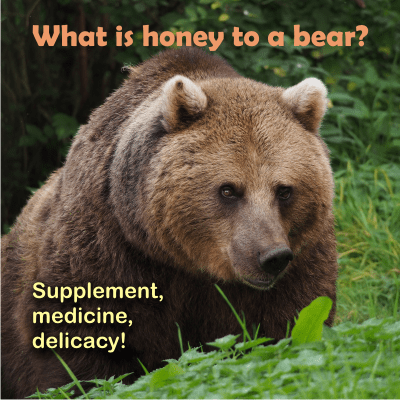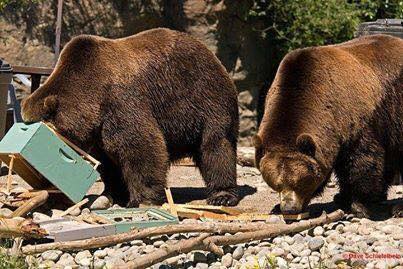Bears love honey. We know this since age 3. But is this true or just another fairy tale? And why doesn’t my cat like it at all?
Taste is a complex issue. We are genetically born with certain tastes, but then they can be shaped by evolution. Educated.
There is a funny video spreading into the world these days, with a bear which is given different kind of honeys. He tastes them all, but seems to have a favorite to which he would always return: Anzer Honey – one of the most expensive honeys in the world. It can sell for as much as $300 a kilogram.
Pity that among those plates there was no Deli Baly (mad honey)– which has psychedelic effects on humans. Perhaps the bear would have chosen differently!
The video reported by DHA explains the sad – for him, funny – for us, story of a Turkish beekeeper, Ibrahim Sedef from Trabzon, north-east of Ankara on the Turkey’s Black Sea coast, who has been harassed by a particularly persistent group of bears that kept devastating and eating all his honey, despite placing the hives into metal cages. More than $10,000 worth of honey got in their bellies! In 3 years.
What he did was to set up recording equipment to track the bears. The beekeeper prepared a feast with all the types of honey he had, to see if the bears had some preferences. And the one visiting bear did have.
But to what purpose? What is the good of knowing the bear’s preferences? (except sharing the video on the Internet, amusing the world, getting a lot of popularity and buying requests? Because, let’s face it, I cannot imagine a better marketing strategy to sell Anzer honey than this!)
So, do bears like honey?
Yes. It’s true that bears have a sweet tooth and Winnie the Pooh was not invented out of thin air. Their taste for sweets, particularly honey (no, there are no cakes and pies in the forest!) are well known by mountain beekeepers. Here are some pictures I’ve found on FB, on Beekeeping International:
You may think their skin is too tough and the bees cannot sting them. Oh, but they do, they defend their colony and honey with the price of their lives, yet in vain. Bears suffer a lot, you can see that in the video below, but don’t go away. The taste of honey is way too good.
And here is a lucky bear. One grown in the backyard, fed from a traditional bowl, using a traditional spoon. With honey, of course. Simply unbelievable.
There are 8 species of bear (Ursidae), widely distributed throughout Europe, Asia, and America. Their diet may be carnivorous, herbivorous, melliferous, or insectivorous, with one type of food predominating according to the time of year. Their tongue differ a little from species to species, according to the different strategies used for capturing and manipulating food, grooming, or for vocal modulation. In some species it can reach 30 cm long!
Brown bears are the largest carnivores in Turkey and mainly live near the Black Sea and Eastern Anatolian regions.
Do all animals like honey?
Definitely not. Animals have specific senses and they perceive tastes differently. What is sweet for humans (and bears…) will taste different to other animals.
But compared to other sweets-lover animals, the bear has preferences.
The Asian otter has a defective sweetness receptor, just like the bear, but compared to it the otter doesn’t show any preference for sweet compounds. In recent study, the spectacled bear showed a strong preference for natural sugars and even some artificial sweeteners. This matches up with their taste receptor genetic data. And our Anzer-honey-lover bear.
Shunks
According to manukahoneyusa.com these animals are actually the foremost predator of honeybees, preferring to chow down on them rather than the bees’ honey stores. However, they will feast on the honey if given the chance, almost like an extra snack after talking out a hive.
Honey Badgers
Coming from the weasel family, the African, Indian, and Southwest Asian native honey badger is a ferocious creature that will, to put it lightly, consume anything. And, as you can imagine, the honey badger’s name stems from its love of honey, and it will eat anything it can find in a beehive, from the honey to the bees.
Honey badgers are also known for their mutually beneficial relationship with birds called greater honeyguides, which guide the honey badgers to the hives, they break in and eat, and then they leave their scraps for their flying partners in crime.

Raccoons are a hindrance for beekeepers, as they love their honey and are known for destroying hives for it.
Opossums, are North American marsupials which prefer feeding on the honeybees themselves and not the honey, but they’ve been known to empty entire hives and their honey stores.
Cats
Cats completely lack the sweet taste receptor on their tongues, and so do their carnivore relatives: Asiatic lions (with only 470 taste buds on their tongues), sea lions, hyenas, the fur seal, the Pacific harbor seal, the Asian otter, the spotted hyena, the fossa and the banded linsang (the last two are catlike mammals) – as shown in a research that compared the taste genes of 12 meat-eating species with that of the dog, which can taste sweetness.
The explanation is given by researcher Peihua Jiang, of the Monell Chemical Senses Center, a nonprofit scientific research institute in Philadelphia: “If you primarily eat meat, there isn’t a need to detect carbohydrates [like sugars and starches], so there is no need to keep this receptor intact.”
Most carnivores can detect bitter flavors, which helps them avoid rancid meat. Meat isn’t sweet, so those taste buds don’t help carnivores survive and are unnecessary. When your meals consist of pretty much one type of item – meat – you don’t need as many taste buds.
Bears on the other hand, though carnivores (among others), retain the sweetness receptor on their taste buds, which might be because of their flexible diets, the researchers added.
The sea lion and the bottle-nose dolphin lack not only the sweet-taste receptor, but also the umami (a savory flavor, long recognized in the East) taste receptors.
The dolphin seems to have even lost the ability to taste bitter substances, and has very few taste buds in general. The researchers’ explanation is that the dolphin swallows the fish whole without chewing, thus bypassing the sense of taste. “They probably don’t need to have a taste to determine what they eat. They may use other means to identify their food.”
Dogs can taste sweetness. And like it a lot. They can steal your ice-cream if you are not watching. Or even worse, your chocolate and then feel sick. They have about 1,700 taste buds. A dog can detect many of the same tastes as humans, but may experience them on a diffused scale. This would explain why your dog puts just about anything into its mouth.
The yellow bullhead catfish (Ictalurus natalis) – a weird animal all coverd in taste buds. Its whole body might as well be one long, slimy tongue. This fish has over 175,000 taste buds stretching from head to tail, with a high concentration in the “whiskers” or barbels near the mouth. This is huge, considering that human tongues usually have between 2,000 and 8,000 taste buds.
Why do they need so many taste buds? Because they live in very deep, dark, muddy waters and the visibility in here is extremely low, so the highly abundant taste buds help the catfish to detect minute quantities and locate the exact position of its food. Scientists have found that catfish with poorly functioning taste buds cannot feed normally. Hence, this great gustatory ability is vital for the existence and survival of the catfish.
Cows have taste buds ranging from 25,000-35,000, which give them an excellent sense of taste―about two to three times more as compared to humans. The taste buds help them distinguish between poisonous and non-poisonous plants.
Rabbits possess about 17,000 taste buds which are located in the mouth and pharynx. Like humans, they too are able to differentiate between sweet, bitter, sour, and salty tastes. In the wild, they are also able to distinguish between poisonous and non-poisonous plants. However, pet rabbits may lose this ability and can be picky eaters.
Pigs have almost 15,000 taste receptors on their tongue. They are omnivores, like humans, and it has been found that they are programmed to eat almost anything that comes up in front of them. It has been seen that pigs like the savory taste more than the sweet one. Even their sense of taste is in combination with their sense of smell. Pigs are partial to bitter flavors.
The octopus can have as many as 1,800 suckers on each of their eight legs, and each is packed with chemical receptors.
Squids possess taste receptors all over their body and are more sensitive to taste than humans. This makes a squid sensitive to chemical disturbances and stimulants in the water.
Bees have taste receptors on their antennae, jaws, and forelimbs, which help them detect the sweetness of a flower. Honeybees are able to distinguish between sweet, sour, bitter, and salty tastes; however, research is still being done as to how this happens.
Flies have chemosensory hairs both on their labellum (think lips for insects) and their tarsi (the equivalent of feet). So when one lands on your sandwich, it’s not simply taking a rest, but is actively sampling your lunch. If the feet like what they taste, then out come the mouthparts!
Butterflies can also taste the world through their feet, but do so for a different reason. Females lay their eggs on the undersides of plants so that the caterpillars have something to eat when they hatch. Mom uses the foot taste test to avoid poisonous plants—a choice that means the difference between dinner and death.
The fruit fly, Drosophila is like mice and humans, attracted to sugars and low concentrations of salt.
Chickens have a mere 50 taste buds, while parrots have several thousand.
Humans
Human tongues usually have between 2,000 and 8,000 taste buds and can detect 5 basic categories of flavors – salty, bitter, sour, sweet, and umami (savory).
But one sweet candy can be sweet in a different way for me than it is for you.
It seems that a quarter of the population has many times more taste-sensitive structures on their tongues than average. They are called “supertasters“! (Perhaps the chefs who make those incredible dishes are from this category) They have more papillae (tiny structures on your tongue that contain taste buds) and are more sensitive to bitter tastes such as coffee, green veggies and grapefruit juice.
And another quarter of people possess so few that they qualify as “nontasters.”
“People live in different worlds of taste intensity,” said Linda Bartoshuk, a physiological psychologist at the University of Florida. “Supertasters live in a ‘neon’ taste world, while others live in a ‘pastel’ world.”
We are born with 5 “primary” tastes sweet, bitter, sour, salty and umami, a savory taste stimulated in humans only by L-Glutamate (MSG) and L-Aspartate (Ikeda, 1909).
Umami and sweet are “good” tastes that promote consumption of nutritive food (such as the building blocks for protein synthesis and energy), whereas bitter and sour are “bad” tastes that alert the organism to toxins and low pH, promoting rejection of foods containing harmful substances (for instance, noxious plants or spoiled or unripe fruits).
Salt can taste either “good” or “bad” to us and be attractive or repulsive to mice, depending both on the concentration of sodium and on the physiological needs of the taster (Lindemann, 2001; Bachmanov et al., 2002).
What is interesting is that though we are not conscious of the change, our tastes changes during lifetime. We are born disliking bitterness but as adults we come to enjoy the bitter taste of black coffee. We educate our tastes in a process of continuous evolution.
Do you know what is 2,000 times sweeter than sugar?
No, it’s not honey.
One recent breakthrough was the discovery of brazzein, a rare sweet protein that is 1,500 – 2,000 times sweeter than sugar. Brazzein is found in the fruit of the native West African Oubli plant (Pentadiplandra brazzeana). It’s small in size, containing only 54 amino acids and its sweetness is not destroyed by 80 degrees C for 4 h.
Industry is now working with this protein to enhance taste in fruits and vegetables, and possibly develop a new tabletop sweetener from corn.
====================
References:
Bear in the featured picture source: https://commons.wikimedia.org/wiki/File:European_Brown_Bear.jpg
Common Sense about Taste: From Mammals to Insects
Researchers tantalize animal taste buds
Do foods taste the same to animals as they do to us?







